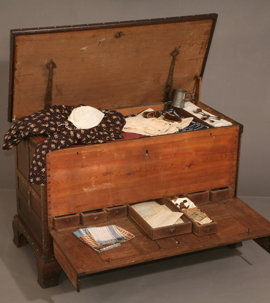
When opened, this chest reveals a multitude of storage options. ID.THF 83283 |
This chest was made in 1801 in Hardy County, Virginia (now part of West Virginia) by Godfrey Wilkin for his son, Jacob. Godfrey Wilkin must have been pleased with his handiwork, as the text on the right and left sides reads “Wel Don” [sic].
Storage space in most middle-class households was minimal by our standards, making chests like this a necessity for the family’s storage needs. Sometimes known as a blanket chest, this chest’s drawers and lid may be locked, assuring the family that their possessions were safely stored.
The top portion of the chest holds household textiles like a woven coverlet and a woolen blanket. Tucked inside are also a woman’s printed cotton dress, a man’s trousers, and a child’s shoes. As secure storage, we see that they included their best Sheffield silver-plate spoons and a pewter mug. The decorative front of this chest tilts to reveal a row of hidden drawers. These drawers likely held important correspondence and, perhaps, a secret storage place for coins and currency. |

